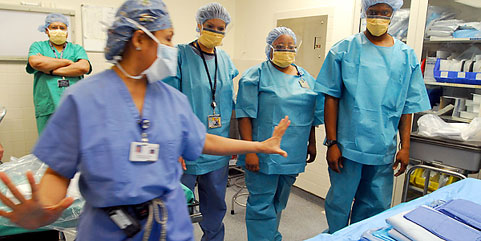
Only 6 percent of U.S. hospitals are well-prepared to receive a patient with the Ebola virus, according to a survey of infection prevention experts at U.S. hospitals conducted October 10-15 by the Association for Professionals in Infection Control and Epidemiology (APIC).
With Ebola emerging in the U.S. for the first time, many questions are being raised about hospital preparedness. A recent nationwide study of nurses revealed that the majority do not feel adequately trained to treat Ebola patients — and this latest data indicate that infection control professionals feel similarly unprepared.
“We know that many hospitals do not have enough staff dedicated to infection prevention and control,” said Jennie Mayfield, BSN, MPH, CIC, president of APIC. “Facilities that are inadequately staffed to begin with are stretched beyond capacity at a time like this. The current crisis demonstrates our lack of surge capacity and should concern everyone.”
In the new survey, APIC’s infection preventionist members were asked, “How prepared is your facility to receive a patient with the Ebola virus?”
Of the 1,039 U.S.-based respondents working in acute care hospitals, about 6 percent reported their facility was well-prepared, while about 5 percent said it was not prepared. The remaining responses reported various levels of preparedness in between the two extremes, with the majority (40 percent) indicating they were somewhat prepared. Survey responses were received from hospitals that ranged in size from less than 100 to more than 400 beds.
According to the survey, one in two hospitals (51 percent) had only one or less than one full-time equivalent infection preventionist on staff. Infection preventionists are experts in identifying sources of infections and limiting their transmission in healthcare facilities.
Among hospitals with 0 to 1 infection preventionists on staff, 4 percent felt well-prepared to receive a patient with the Ebola virus, compared to 31 percent of survey respondents with 11 or more infection preventionists on staff.
“The survey highlights the short shrift given to infection prevention at many U.S. hospitals,” said Katrina Crist, MBA, APIC Chief Executive Officer. “The Ebola outbreak illustrates why facility-wide infection prevention programs are critical and require adequately trained, staffed, and resourced infection control departments. The unique skill set of the infection preventionist is needed to get out in front of this outbreak and prevent the next public health issue from escalating to a crisis.”
According to the CDC, approximately 1 in 25 people in the U.S. get healthcare-associated infections and nearly 75,000 people die each year with these infections, about twice the number who die from auto accidents. Healthcare-associated infections cost the U.S. healthcare system in excess of $30 billion annually. Many healthcare-associated infections can be prevented with proper infection prevention practices.
However, said Mayfield, “because our infection preventionist members are having to focus so much attention on Ebola, they are very worried about what other infectious diseases we might be missing.”
APIC is calling on healthcare facilities to assess their infection prevention programs by looking at all the care and services provided by the institution and determining the appropriate level of personnel and resources necessary to meet the increased need. APIC is urging facilities to focus on three aspects of infection prevention in order to effectively protect healthcare workers, patients, and the public.
- Personnel – Because Ebola readiness demands intense, in-person training and drilling led by infection prevention experts, adequate infection prevention staffing is critical.
- Training – To ensure that guidelines are followed precisely 100 percent of the time, healthcare workers must be trained and drilled on safety protocols so that they can demonstrate proficiency in essential infection control practices.
- Technology and equipment – To maximize efficiencies and provide real-time data to help infection preventionists detect and control infectious diseases, healthcare facilities must invest in infection tracking and monitoring technology.
